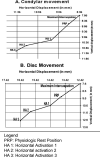Stress distribution in the temporomandibular joint after mandibular protraction: a three-dimensional finite element study
- PMID: 24901066
- PMCID: PMC8631882
- DOI: 10.2319/091913-690.1
Stress distribution in the temporomandibular joint after mandibular protraction: a three-dimensional finite element study
Abstract
Objective: To evaluate the stress patterns in temporomandibular joint (TMJ) during mandibular protraction at different horizontal advancements with constant vertical height in a construction bite using a three-dimensional finite element method.
Materials and methods: A three-dimensional computer-aided model was developed from the magnetic resonance imaging (MRI) of a growing boy (age 12 years) using MIMICS software (version 7.0, Materialise, Leuven, Belgium). Stresses with constant vertical opening of 5 mm changing the sagittal advancements from 0 mm to 5 mm and 7.5 mm were recorded. Differences in magnitude and pattern of stresses were compared.
Results: The tensile stresses in the posterosuperior aspect of the condylar head and on the posterior aspect of the glenoid fossa migrated posteriorly with increased bite advancements. The location of tensile stresses changed in the condylar head and fossa on mandibular protraction of 5 mm to 7 mm.
Conclusion: This study indicates that larger horizontal advancements of construction bites may not be favorable for tissues of TMJ. Clinical application necessitates study on an animal model.
Keywords: 3D FEM study; Articular disc; Condyle; Fossa; Horizontal advancements; Mandibular protraction; Stresses; Temporomandibular joint.
Figures












References
-
- Tanaka E, Tanne K, Sakuda M. A three-dimensional finite element model of mandible including the TMJ and its application to stress analysis in TMJ during clenching. Med Eng Phys. 1994;16:316–322. - PubMed
-
- Zhou X, Zhao Z, Zhao M. Analysis of the condyle in the state on the mandibular protraction by means of the three-dimensional finite element method [in Chinese] Zhonghua Kou Qiang Yi Xue Za Zhi. 1999;34:85–87. - PubMed
-
- Beek M, Koolstra JH, van Ruijven LJ, van Eijden TM. Three-dimensional finite element analysis of the human temporomandibular joint disc. J Biomech. 2000;33:307–316. - PubMed
-
- Tanaka E, Rodrigo DP, Tanaka M, Kawaguchi A, Shibazaki T, Tanne K. Stress analysis in TMJ during jaw opening by use of three-dimensional finite element model based on magnetic resonance images. Int J Oral Maxillofac Surg. 2001;30:421–430. - PubMed
-
- del Pozo R, Tanaka E, Tanaka M, et al. Influence of friction at articular surfaces of temporomandibular joint on stresses in articular disk: a theoretical approach with the finite element method. Angle Orthod. 2003;73:319–327. - PubMed
Publication types
MeSH terms
LinkOut - more resources
Full Text Sources

